
|
Keyword: star trail
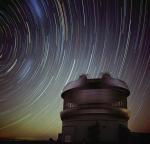 Gemini South Star Trails
Gemini South Star Trails
1.09.2006
Stars seem to arc through southern skies in this surrealistic time exposure -- recorded before moonrise from the Gemini South Observatory, Cerro Pachon, Chile, Planet Earth. During the one hour 40 minute exposure camera and tripod were fixed, so the concentric star trails are a reflection of Earth's daily rotation about its axis.
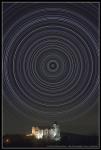 Star Trails Over Vienna
Star Trails Over Vienna
14.07.2005
As the Earth spins on its axis, the sky seems to rotate around us. This motion, called diurnal motion, produces the beautiful concentric trails traced by stars during time exposures. In the middle...
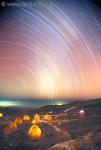 The Star Trails of Kilimanjaro
The Star Trails of Kilimanjaro
11.09.2004
The night had no moon, but the stars were out. And camped at 16,000 feet on Mt. Kilimanjaro, photographer Dan Heller recorded this marvelous 3 1/2 hour long exposure. Here the landscape is lit mostly by the stars.
 Orion Rising
Orion Rising
25.12.2002
Orion always comes up sideways ... and was caught in the act earlier this month by astronomer Jimmy Westlake, stargazing eastward over the Rocky Mountains north of Leadville, Colorado, USA. To make this gorgeous image, Westlake placed his camera on a tripod for two exposures.
15.11.2002
Spanning southern to northern skies, stars trail across this panoramic view of the African night from equatorial Kenya. The three hour long exposure was made on a clear, dark, mid November evening facing due west and covers just over 180 degrees along the horizon.
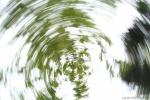 Circum axial Leaf Trails
Circum axial Leaf Trails
19.05.2007
Are photographs of star trails really evidence of the Earth's rotation about its axis? Yes they are, and science journalist Trudy E. Bell discovered that there is a simple way to demonstrate this, if you have the stomach for it.
 Southern Cross Star Colors
Southern Cross Star Colors
8.07.2004
Fix your camera to a tripod, lock the shutter open, and you can easily record an image of star trails, the graceful concentric arcs traced by the stars as planet Earth rotates on its axis.
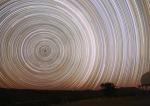 11 Hour Star Trails
11 Hour Star Trails
15.09.2006
Fix your camera to a tripod, lock the shutter open, and you can make an image of star trails - graceful concentric arcs traced by the stars as planet Earth rotates on its axis. Of course, the length of the star trails will depend on the exposure time.
|
January February March April May June July |
|||||||||||||||||||||||||||||||||||||||||||||||||